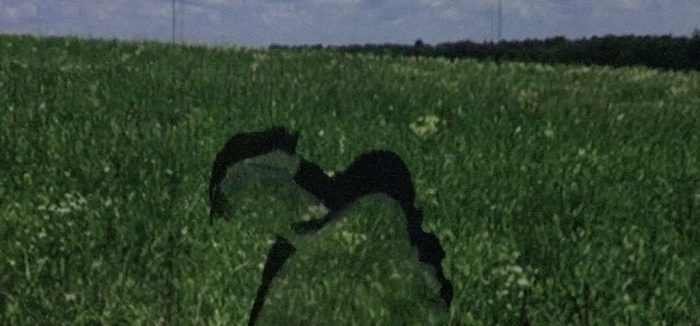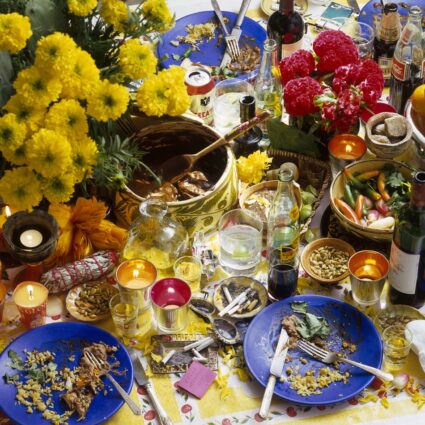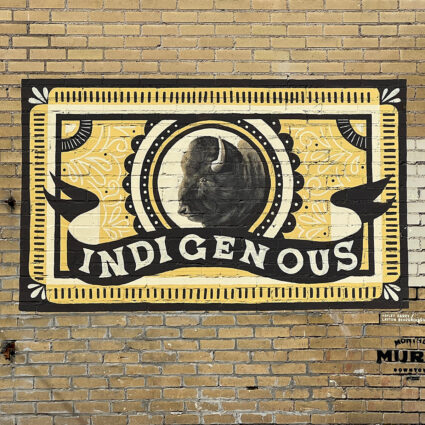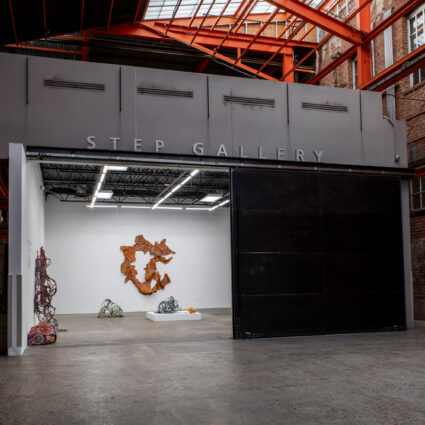At Sweet Pass Sculpture Park, Brook-Lynne Clark finds signs of her life on the Blackland Prairie in Big Tex is Burning, which tracks her relationship to embedded histories of Dallas.
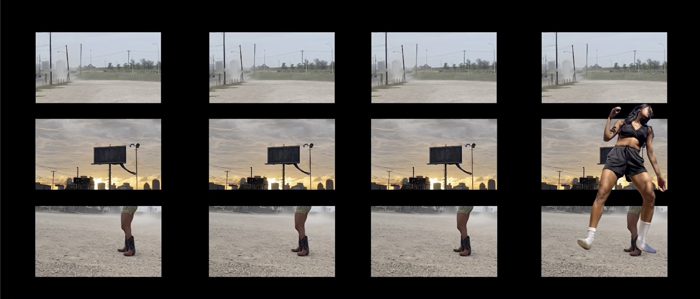
Bottomland
May 14–September 24, 2022
Sweet Pass Sculpture Park, Dallas
Bottomland is the result of a group search for the Texas Blackland Prairie.
Most conservationists estimate there’s less than 1 percent remaining of the black velvet soil and its original ecosystem of tall dropseed grasses, wild indigos, and compass plant, whose cardinal directing leaves met the outstretched hands of early settlers feeling their way through the dark. Sweet Pass Sculpture School artists visited sites of inheritance around North Texas where this habitat still exists in small, mediated patches, and where it’s been covered by infrastructure and all-time sad stories. It’s not about loss. The field lessons of this two-week program attend to the discipline of investigating what remains as abundance.
So does the culminating Bottomland exhibition at Sweet Pass Sculpture Park. The mostly outdoor project space, essentially the backyard of both Dallas’ Arkikosa (Trinity) River and incessant new construction in Trinity Groves, regularly manifests the extremes of its context in site-responsive work on view at the remove of contemporary art. Sweet Pass emerges as an important critical collective with Bottomland. The show—featuring works by Nathalie Alfonso, Susana Oliveros Amaya, Brook-Lynne Clark, Isaac Dunne, Emily Lee, and Hélène Schlumberger—is pushed past the glass by movement and installation artist Clark, who ends a walkthrough of Bottomland with signs of her own life.
A visitor must first follow the logic of the outdoor works to experience Clark’s Big Tex is Burning (2022, three-channel video, runtime: 6:47). Dunne marks the space between the impending and inevitable—the last gasp before a new build—with 3 Porta Potties. One side-eyes Philip Johnson’s John Fitzgerald Kennedy Memorial, which looks more like a city pool bathroom than an apology monument. Another flags the unit occupied with a hand-drawn flower on the door handle; inside Porta Potty (Frankford Church), tall grasses sprout from the floor, a nod to the “miracle prairie” conserved by that so-named house of worship. An actual gash in the earth announces itself like a multi-million-dollar campus building in Schlumberger’s The Hole: A Drama.
To synthesize Dallas’ mythologies with anything personal seems a fearsome rite. Enter Clark’s everyday archives, a trove of iPhone videos that track her impeccably styled outfits, her face in shifting sun, afternoon vistas, nighttime departures, little celebrative performances.
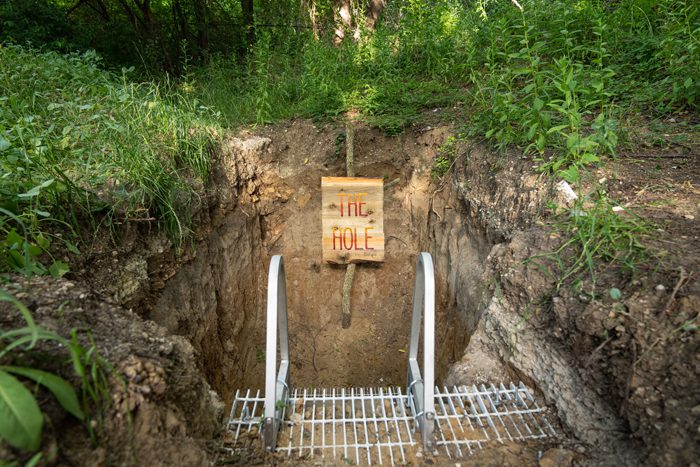
“So, I just said that. Right now, I’m in a really good place,” Clark laughs in one video, her free hand balancing a takeout cup. “North Park!”
Those lines are heard just before a weather alert blares on a car radio Clark’s Big Tex is Burning, named for the fifty-two-foot-tall State Fair of Texas mascot’s very public, ghastly demise in 2012. The Dallas Police Department told TV news stations the cowboy perished of natural causes: an electrical fire.
During the Sweet Pass Sculpture School program, Clark enjoyed the challenge to look for endangered land—the rarified premium, the bulldozed origin, the marked-up rescue—under everything. She learned North Park was built on ninety-seven acres of cotton fields leased to Dallas developer and art mogul Raymond Nasher. With a friend, she stood outside the inexplicably locked center section of the food court as sunshine washed over images of plant life on the façade of an empty secret garden. Clark laughs to remember the moment those lines escaped her mouth.
The loop of Big Tex is Burning starts with movement artist Hailey Summers sitting in front of a projection screen gridded with Google image search results for Clymer Meadow Preserve, a study of the Blackland Prairie northeast of Dallas and another site visited during Sculpture School. Clark is scrolling through ominous storm scenes and trad landscapes to find an opener. We witness this process for a full forty seconds until Summers clicks a photo and verdant grass fills the frame behind Summers. It’s lush. “Yeah,” Clark says offscreen, vibing.
Summers’ shadow dominates the figure from which it is cast against the projected field. The viewer cannot tell who is cradling what, trained now to recognize effect as form. Controlled fires lit from nowhere, burning nothing, appear in collaged rounds, the sound of their crackling an almost tactile force.
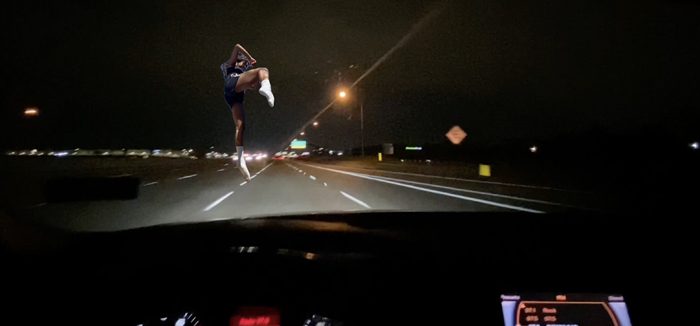
This is Clark’s prelude to Dallas as seen from above its many highways. Then, Dallas from a car with 97.9 The Beat on the radio dial. Clark’s dancing image lands on the windshield and the car just keeps going. She strives and tires, focusing hard on remembering something—maybe the steps. Natural sound hums under most of the score in stops and starts.
The moment it seems Clark is rhapsodizing in a field or lost in some visual rhyme, a dark tone hits to test her joy. “You like music? I don’t. Everybody says they do,” quips a male voice from a found commercial made for Dallas sometime in the 1980s.
A fragment of Kendrick Lamar’s “Sing About Me, I’m Dying of Thirst” looks to high towers and hopes, above all, for true memory. “You dying of thirst, so hop in that water, and pray that it works,” goes the line that closes the loop, calling back to an earlier image of Clark sprawled out at the shore of the North Park fountain outside Dillard’s, making its shape her own. Neither is ever still. Clark shows up as herself in constant transit between the moment’s impulse and the histories embedded at her feet. To absorb these crossing forces and keep moving is to remember everything, to be memory itself where it’s otherwise absent.
Bottomland continues through September 24, 2022 at Sweet Pass Sculpture Park, 402 Fabrication Street in Dallas. Check the Sweet Pass Sculpture Park website for updates on events and open hours.
